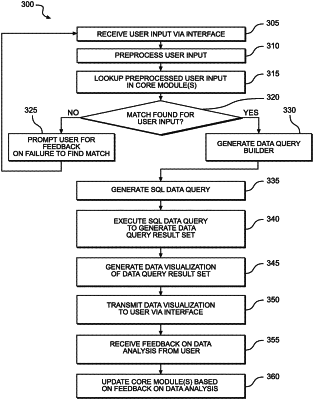| CPC G06F 16/24522 (2019.01) [G06F 16/2428 (2019.01); G06F 16/2448 (2019.01); G06F 16/24573 (2019.01); G06F 40/284 (2020.01)] | 20 Claims |

|
1. A computer-implemented method for converting a natural language query into a structured database query, the computer-implemented method comprising:
receiving, by a dashboard controller system, natural language query text of a user, wherein the natural language query text is indicative of a request of the user for information from a database system;
transforming, by the dashboard controller system, each word of the natural language query text to a respective base lemma, thereby generating a set of transformed words corresponding to the natural language query text;
comparing, by the dashboard controller system, each transformed word of the set of transformed words to a database corpus of stored data elements to determine whether the transformed word has a respective matching data element in the database corpus, wherein the database corpus comprises a first data ecosystem;
based on the comparing, identifying a first unmatched transformed word of the set of transformed words that does not have a respective matching data element in the database corpus;
requesting, by the dashboard controller system, and from the user, a user input to assist in correlating the first unmatched transformed word;
receiving, by the dashboard controller system, and in response to the requesting, a user response, wherein the user response comprises an indication that the first unmatched transformed word matches a second data element of a second data ecosystem;
generating, by the dashboard controller system, a query builder collection based on the user response and the set of transformed words;
generating, by the dashboard controller system, a structured data query based on the query builder collection;
executing, by the dashboard controller system, the structured data query against at least one data table of the database system to generate a data query result;
selecting, by the dashboard controller system, a data visualization for the user;
generating, by the dashboard controller system, a display of the data query result via a personalized data query dashboard based on the selected data visualization for the user;
transmitting, by the dashboard controller system to the user, a request for feedback information about the generated display of the data query result;
receiving, by the dashboard controller system from the user, feedback information about the generated display of the data query result;
and updating at least one data module of the database system based on the feedback information.
|